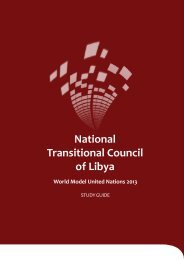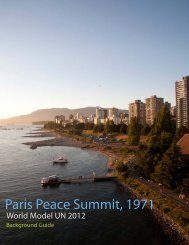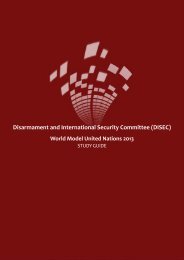Social, Humanitarian and Cultural Committee (SOCHUM)
Social, Humanitarian and Cultural Committee (SOCHUM)
Social, Humanitarian and Cultural Committee (SOCHUM)
You also want an ePaper? Increase the reach of your titles
YUMPU automatically turns print PDFs into web optimized ePapers that Google loves.
above. 82 While these works can be read in translation,<br />
it is clear that one loses some aspects of the author’s<br />
original intent in a foreign language; in order to fully<br />
underst<strong>and</strong> the cultural significance of these works,<br />
it is necessary to maintain them in their original<br />
languages. 83 Languages also encode what their<br />
respective cultures know or value about a number<br />
of other aspects of society, including religion, justice,<br />
education, kinship, medicine, <strong>and</strong> nature, collectively<br />
known as intangible cultural heritage. 84 As much of<br />
this heritage is inherited through language, language<br />
death <strong>and</strong> endangerment has the risk of eliminating<br />
countless indigenous cultures. 85 While a few cultures<br />
have survived language endangerment, most notably<br />
those of the irish <strong>and</strong> Jewish peoples86 , the threat of<br />
language death to local cultures is undeniably strong.<br />
Possible Solutions<br />
Although the situation is grim for many endangered<br />
languages, there are a number of steps the<br />
international community can take to prevent these<br />
languages from becoming extinct. The undeniable<br />
first step is to increase information-gathering efforts<br />
about the status of endangered <strong>and</strong> non-endangered<br />
languages across the world. the Ethnologue<br />
represents a positive start in this direction, but much<br />
more information is needed before informed policy<br />
decisions can be made, including the age of speakers,<br />
the attitudes of speakers toward their mother tongue,<br />
<strong>and</strong> the specific causes of language endangerment<br />
in each case. 87 Additionally, by maintaining a<br />
core set of speakers over the past century, some<br />
languages appear immune to the forces of language<br />
endangerment, <strong>and</strong> it is vital to underst<strong>and</strong> what has<br />
prevented the decay of these respective languages. 88<br />
Beyond this type of information gathering, there<br />
are two main categories of solutions to the problem<br />
of language endangerment: documentation <strong>and</strong><br />
revitalization. These two categories can be applied<br />
separately or together, depending on how seriously<br />
endangered a language is, its prognosis for survival,<br />
<strong>and</strong> the priorities of those funding the efforts are.<br />
in cases of extreme language endangerment,<br />
the primary goal is usually documentation so<br />
that linguists can study the language, <strong>and</strong> future<br />
generations can have access, through translation, to<br />
their culture’s oral traditions. When a language is less<br />
seriously endangered, <strong>and</strong> more funding is available,<br />
the community might initiate revitalization efforts to<br />
rebuild a strong base of speakers.<br />
Documentation, also known as corpus planning,<br />
aims to ensure that a language persists in records<br />
after the death of the last speaker. These efforts<br />
usually involve the codification of the language<br />
in a st<strong>and</strong>ard form <strong>and</strong> the development of an<br />
orthography, or written form, if such a system does<br />
not already exist. documentation also includes<br />
the production of dictionaries <strong>and</strong> other types of<br />
written <strong>and</strong> oral archives. 89 in recent years, these<br />
archives have been undergoing a slow transition<br />
to the internet, which has made them much more<br />
easily accessible to the general population. On 21<br />
June 2012, Google announced that it was launching<br />
the Endangered Languages Project with a number of<br />
organizations involved in language preservation in<br />
order to collect online samples of the thous<strong>and</strong>s of<br />
dying languages across the world. 90 In one remarkable<br />
case involving a digital archive, a group of speakers of<br />
Arapesh, an endangered language on the northern<br />
coast of Papua New Guinea, found an archive of their<br />
language through Facebook <strong>and</strong> have since reached<br />
out to the linguist responsible for assistance with<br />
their revitalization efforts. 91 this example reinforces<br />
the importance that linguists play in documentation<br />
efforts <strong>and</strong> shows that documentation can in itself be<br />
a method of revitalization, as indigenous populations<br />
often do not attempt to maintain their language until<br />
the work of linguists makes them underst<strong>and</strong> the<br />
value of their own tongue. 92<br />
25<br />
Melbourne Host Directorate PTY LTD | Office of Media <strong>and</strong> Design

















